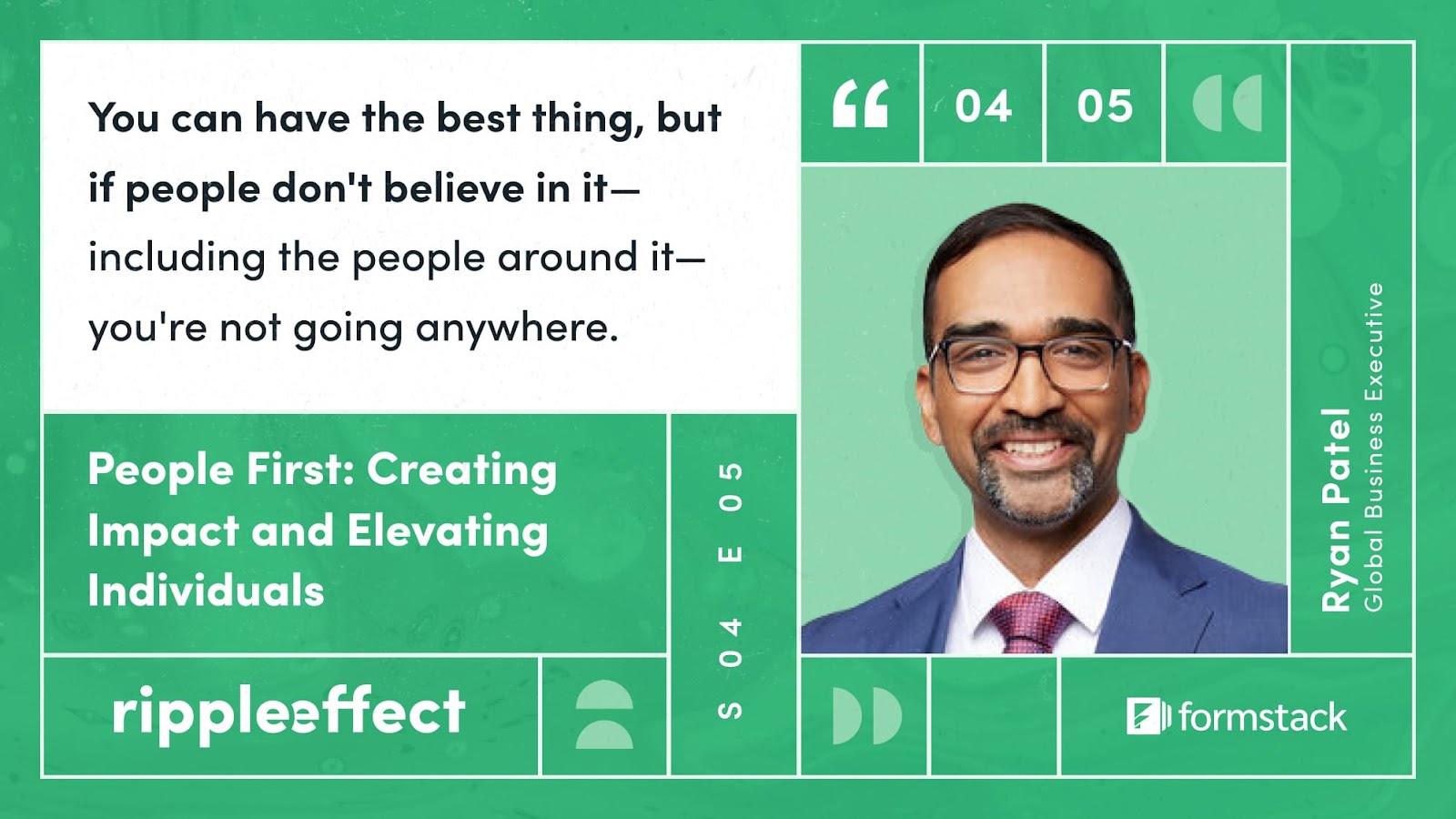“No matter who you are, you can really do simple things and make an impact.”
Do you believe the statement above? Ryan Patel has based much of his career on this belief.
He has focused on scaling businesses and is now a world-renowned go-to authority on global business, political economy, and corporate governance. You’d think he’d be laser focused on profits and numbers, but he’s actually much more concerned about people.
In a recent episode of Formstack’s Ripple Effect podcast, Ryan chatted with Chris about how individuals can make a big impact within an organization, from small start-ups to large corporations.

His people-first mentality puts the focus on employees and reveals the power they have to bring forth major change. If you’re an individual contributor who wants to make an impact within your organization, here are just a few ways to make that happen.

Listen Now: Want to jump right into Ryan’s episode? Listen to People First: Creating Impact and Elevating Individuals now!
Join, lead, or create a committee.
Is there an issue within your organization you’d like to solve? If there isn’t a committee focused on solving the issue, consider creating one to champion a plan of action. Having individuals held responsible to deliver on impact can be a complete game-changer within your org.
With so many competing priorities, organizations oftentimes have to push some issues to the backburner. If you see a problem that needs fixing, you have the power to create a solution—even if it doesn’t fall within your role, job scope, or department.
Whether you’re wanting to infuse more DE&I strategies across your organization, fix a common process roadblock, or create more sustainable practices, you have the power to turn your concern into action.
Create a cross-functional committee built of employees of different skills, roles, and levels. You may want to look into the principles of a guiding coalition to help you build the team. Once you have a small group together, you can focus on creating an action plan that will bring change, which can include both short-term and long-term milestones and goals.
Related: 5 Change Management Tips Everyone Should Follow
Pitch your ideas to key players.
If you have an idea of how to reimagine a process or system, pitch it to key players within your organization.
Imagine you’re on Shark Tank, but instead of garnering an investment from Kevin O’Leary or Barbara Corcoran, you’re gathering buy-in from managers and directors. Even one conversation with the right person within your organization could spark a huge change.
First, create a pitch deck that includes:
- Explanation of the problem
- Why a solution is needed
- Possible solutions
- Resources needed
- Timeline and major milestones
- Expected positive outcomes
Try to keep your pitch deck short and to the point. At this stage, it’s not about the details but the overarching picture and goal. Once your deck is finalized, pitch it to your manager, then whoever else may be necessary to get buy-in from.
You may also want to pitch your idea to a few key players to gather feedback before pitching to your manager or directors. This can help you refine your ideas, improve your pitch, and possibly encourage others to raise their hand to help.
Create an employee resource group.
Bringing people together is key to creating a healthy and supportive work environment. It is also an excellent way to build upon the power of an individual. One voice can make an impact, but many working together can create great change.
To harness the power of individual voices at your organization for communal good, consider starting some employee resource groups. These are voluntary, employee-led groups whose aim is to foster a diverse, inclusive workplace aligned with the organizations they serve.

Employee resource groups are based on common interests, backgrounds, or demographic factors such as gender, race, or ethnicity. They provide employees a place to share similar experiences, provide support, and discuss challenges. Whether in-person, hybrid, or remote, they can be a great way to impact the culture of your organization.
If you’re interested in starting some employee resource groups, it’s best to survey your employees to see what types of groups they might be interested in. Here are just a few ideas:
- Working moms
- LGBTQ+
- LatinX
- Young professionals
- Parents
- People of color
- Veterans
- Caregivers
The format and programming of your employee resource groups will vary depending on your organization, the group theme, and how many individuals are included. Each group should be in charge of defining the scope of their group, membership eligibility, and what success means to them.

You can make an impact today.
It can be difficult to see how you as an individual can make an impact within an organization. But as Ryan shares in his Ripple Effect episode, it just takes one voice to start something amazing. What impact will you choose to make today?
Learn more about how you can make an impact, give individuals a voice, and create social good by listening to Ryan’s Ripple Effect episode People First: Creating Impact and Elevating Individuals now.











